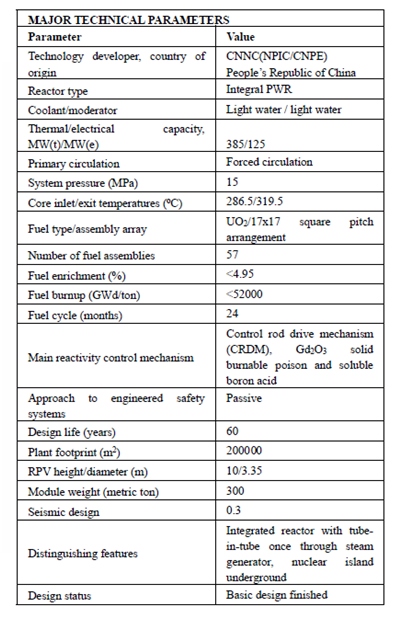Dan Yurman looks at plans for Small and Micro Nuclear Reactors. A UK report on Micros that generate 30MW says it’s an opportunity for the country to own the IP and export units that are simple in design, factory constructed and capable of being sited in remote locations. Given the rough ride nuclear can get, the report warns that progress will depend on political, regulatory and financial support. Meanwhile, in the US, Westinghouse will have a 25MWe unit ready to test by 2022. And while the world waits for such Micros, China will begin construction at the end of this year of a 125MW Small Modular Reactor, expected to be operational in 2025.
Westinghouse launches new SMR effort
After several earlier false starts, including a complete withdrawal in 2014 from efforts to enter the SMR market, Westinghouse buoyed with a $12.9 million grant from the U.S.Department of Energy, is making another go of it. The firm said it will spend $28.9 million to demonstrate the readiness of the technology of its 25-MWe eVinci micro-reactor by 2022.
The government money, which is covering about half of the costs, will cover costs used toward design, analysis, licensing to manufacture, siting, and testing work.
The monolith will serve as the second fission product barrier (the fuel pellet is the first barrier) as well as the thermal medium between the fuel channels and heat pipes. The heat pipes will extract heat from the core using a technology based on thermal conductivity and fluid phase transition.
Key technical attributes
On its website Westinghouse said the reactor’s small size and innovative design set it apart. (Technical Profile – PDF file) Here’s a short list of key technical details.
- Transportable as a reliable energy generator
- Fully factory built, fueled and assembled
- Output of 25 MWe electrical
- Up to 600ºC process heat for petro chemical and other industrial uses
- 5- to 10-year life with walkaway inherent safety
- Target less than 30 days for onsite installation
- Autonomous load management capability
- Proliferation resistance through encapsulation of fuel
- Minimal moving parts

Challenges ahead for a new design
Westinghouse told Power Magazine that it faces several key challenges. First among them is getting enough HALEU fuel. The Department of Energy is supporting multiple efforts to address that issue including a contract to produce it by Centrus Corp by 2020 and deployment of a HALEU-based TRISO-X fuel fabrication pilot line at the Oak Ridge National Laboratory.
Other issues which are faced by all SMR developers include the question of how many deals are needed to be inked in their order books to get investors to provide the fundsfor factory production facilities.
Because the design is unique, Power Magazine noted that Westinghouse will have to go through the long and expensive safety evaluation process at the NRC. The firm told Power Magazine it faces “first of a kind” challenges in licensing, instrumentation, remote reactor monitoring, and logistics.
“These challenges require careful risk management and planning, but they are not considered showstoppers and their management is part of the Westinghouse eVinci reactor development program.”
Small modular reactors have big potential market in UK, says government-funded report
(NucNet): Micro nuclear reactors (MNRs) are a feasible option for the UK and have a potential market in the hundreds by 2030, a new government-funded report has concluded.
The report, produced by Nuvia, WSP and Atomic Acquisitions, concludes that there is great potential for development of MNRs between 2030 and 2035.
It says MNRs, typically under 30 MW, could bring significant economic benefits to the UK but must be “decisively supported” because they will only proceed with clear support and facilitation of political, regulatory and financial factors.
The study, Market and Technical Assessment of Micro Nuclear Reactors, says;
“Due to their size and unique characteristics, there are several potential market opportunities for MNRs. A potential global accessible market of up to 2,850 megawatts has been estimated by around 2030,” the report says.
“A potential MNR industry could enable the UK to grow indigenous civil nuclear reactor manufacturers gaining intellectual capital at low entry cost. At present this core part of the civil nuclear supply chain is not provided in the UK.”
In its conclusions the report says key advantages of micro reactors include simplicity of design, including safety systems; potential ease of construction through factory construction; lower overnight cost of each unit resulting in ease of financing; and the possibility of placing reactors in remote locations.
December construction start for Chinese 125 MWe SMR
(WNN) China’s Ministry of Environment is proceeding to build an ACP100 small modular reactor (SMR) at Changjiang, Hainan, with construction to begin by the end of this year.

According to Chinese publication Nuclear World, construction is expected to take 65 months with the 125 MWe unit expected to start up by May 2025.
According to data about the ACP100 in the IAEA “SMR Book,”the ACP100 is a multipurpose power reactor designed for electricity production, heating, steam production or seawater desalination and is suitable for remote areas that have limited energy options or industrial infrastructure.”
The design, which has 57 fuel assemblies and integral steam generators, (see table right) incorporates passive safety features and will be installed underground.
A two-unit ACP100 plant will be located on the northwest side of the existing Changjiang nuclear power plant, according to the 22 March announcement. The site is already home to two operating CNP600 PWRs, with two Hualong One units also planned for construction at that site.
***
Dan Yurman is the author of Neutron Bytes and writes on nuclear matters.
This article is published with permission.
Next generation nuclear: 25MW, smaller, safer, can be sited anywhere



